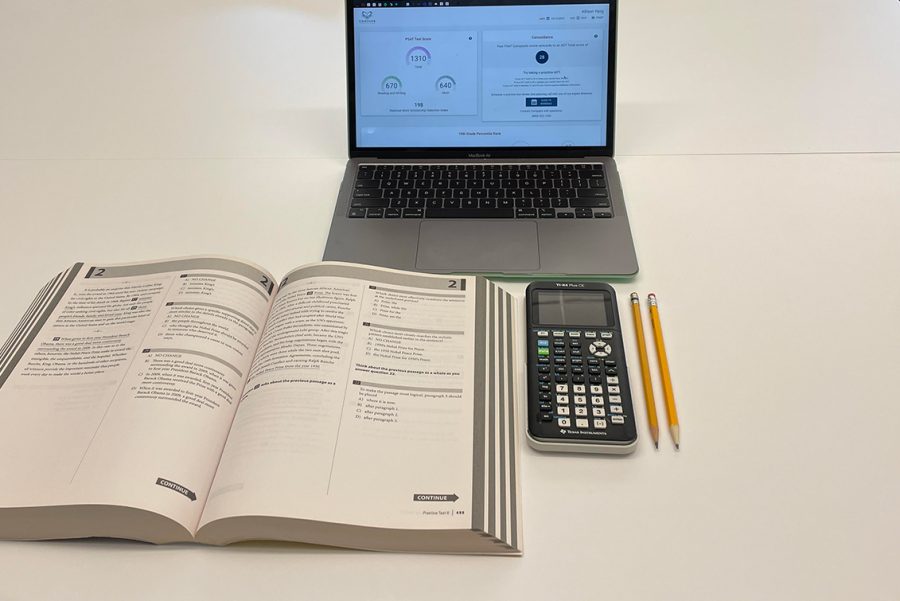Students share flaws of standardized testing, strengths of grades in college admissions process
Photo credit: Allie Yang
A laptop displays a PSAT score report while surrounded by a book of practice tests, graphing calculator and pencils. Lacey Thompson (’24) took the PSAT on Oct. 12 and said standardized tests for college admissions did not demonstrate her strength as a student.
January 19, 2023
After seeing her sister, Kaitlyn Kim (’21), apply for college, Natalie Kim (’23) prepared for and took the SAT. Ultimately, she chose not to submit her scores because she found the standardized tests used for college admissions to be “limiting.”
The SAT and ACT differ in formatting and scoring but serve the same purpose. According to The Princeton Review, both tests “measure a high school student’s readiness for college and provide colleges with one common data point that can be used to compare all applicants.” In 2019, 78% of applicants submitted their standardized test scores to colleges. During the pandemic, test centers and schools reduced their capacities which caused one million test registrations to be canceled. As a result, 11% of schools of schools required scores in 2020. In the most recent admissions cycle, only 4% of schools required scores in students’ applications.
Test optionality began in 1970 at Bowdoin College. However, it gained popularity in the 2000s due to criticisms regarding the tests’ equity, specifically their tendency to cater to affluent applicants.
Senior Genevieve Sive agrees with these criticisms. She said money affects applicants’ access to educational resources that can improve their performance on standardized tests.
“There’s a lot of factors that can play into standardized testing, like extra time,” Sive said. “Some schools require a psych evaluation, which is very, very expensive, so not all families can pay for that. I was so lucky to have [tutoring], but a lot of families can’t afford it because it’s expensive.”
Kim said the tests’ socioeconomical unfairness hinders college admissions officers’ ability to compare applicants. She said when done well, they demonstrate ample resources as opposed to ample skill. This is partially why she supports the increasing number of colleges that no longer require standardized test scores.
“A lot of schools are … going test-blind. That’s a good direction,” Kim said. “[Grades are] a lot more cohesive and representative of somebody’s growth rather than how good their tutor is [or] how good the programs are. Some schools are still sticking with it; I have a feeling it’s going to phase out since it’s already being questioned.”
Junior Lacey Thompson (’24) has not taken the SAT or ACT. However, by taking the PSAT for the second time, she was able to conclude the standardized tests did not prove her capability as a student.
“Standardized testing doesn’t showcase my intelligence or academic abilities,” Thompson said. “I’m much better at everything else involving school rather than standardized testing. It works for some, just not for me.”
According to Director of College Guidance Ivan Hauck, Thompson is not alone. He said many students have higher academic performance in the classroom as opposed to the testing room. He also noted test preparation’s effectiveness and difficulty for students to manage.
“We have a lot of impressive, high-performing students here who don’t necessarily do well on a standardized test,” Hauck said. “The students who really dedicate a lot of time and energy to test preparation — whether it’s on their own using free resources like Khan Academy or external test prep — [do] better on testing, but it oftentimes is challenging for students to find the necessary time and energy to dedicate to test prep when they have so many other things going on.”
In addition to being inadequate at presenting personal strengths, senior Lily Prokop said standardized tests can also foster an unhealthy environment if students compare scores.
“If someone wants to set a goal for themselves against a specific score, I can see that being productive, but I don’t think it helps to be competitive against friends at school,” Prokop said. “I could see that being more stressful than motivating … It’s not like people have chosen to be in this competition.'”
Including breaks, the SAT takes 3 hours and 15 minutes, and the ACT takes 3 hours and 30 minutes. Since test-takers are to complete the exams in one sitting, Kim said the tests lack relevance beyond high school.
“What is fundamentally wrong with them is you sit down once, take it and that’s it,” Kim said. “That’s a great demonstration of a certain type of testing that happens very rarely in your career or college. You still have opportunities to up your grades without slipping [on] one final that’s make-or-break.”
Prokop also said the tests were inapplicable to college and beyond but because of their content rather than time restraints.
“There aren’t a ton of situations where you’re given a set of algebra problems you need to manage your time [for] and do,” Prokop said. “For the reading section, some of the questions I can see [are] similar to something I might do in an English class. But, there are some questions that I don’t think you would end up using.”
Unlike standardized tests, grades are given over the entire course of an applicant’s high school career. Sive said because they are spread out over time, grades are better able to present favorable qualities to college admissions officers.
“Grades show progress and stability. If you progress from B’s in freshman year and get more A’s along the way, it shows you’ve learned skills to achieve, push yourself forward and adjust your learning,” Sive said. “They show you change your mindset and have grown. Also, you can start out with great grades and keep your great grades [which] shows good stability college admissions committees would love to see.”
Hauck acknowledged standardized tests’ role in the college admissions process and also emphasized the importance of in-school academic performance.
“Testing is one tiny part of the entire application process,” Hauck said. “Sometimes students choose to spend a lot of time and energy on it, but when we talk about the holistic high school experience, engagement in classes is much more important. Doing well in classes is much more important.”
Kim said, in comparison to standardized tests, grades can successfully demonstrate a student’s potential. She said potential is an important trait for colleges to seek because it indicates productive students with the ability to improve.
“Grades are a better indicator of a student’s … potential,” Kim said. “If you have a student that has drive, motivation and is able to put in the work, you have somebody who clearly is very hardworking. Maybe they’re struggling at first, but they’re able to be quick on their feet … Colleges [are] not just taking the student as they are. [They are] taking them for their potential, what they can do.”










Lucy Williams • Jan 20, 2023 at 10:44 am
WOW! Super important topic Allie, this article was much needed and super enlightening;)